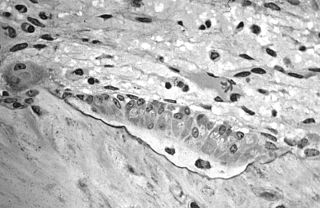- Osteoid
-
Osteoid 
Osteoid, containing two osteocytes, being synthesized by active osteoblasts. In histology, osteoid is the unmineralized, organic portion of the bone matrix that forms prior to the maturation of bone tissue. Osteoblasts begin the process of forming bone tissue by secreting the osteoid as several specific proteins. When the osteoid becomes mineralized, it and the adjacent bone cells have developed into new bone tissue.
Osteoid makes up about fifty percent of bone volume and forty percent of bone weight. It is composed of fibers and ground substance. The predominant fiber-type is Type I collagen and comprises ninety percent of the osteoid. The ground substance is mostly made up of chondroitin sulfate and osteocalcin.
Disorders
When there is insufficient mineral or osteoblast dysfunction, the osteoid does not mineralize properly, and it accumulates. The resultant disorder is termed rickets in children and osteomalacia in adults.
In very rare cases, primitive transformed cells of mesenchymal origin exhibit osteoblastic differentiation and produce malignant osteoid, which results in the formation of a malignant primary bone tumor known as osteosarcoma or osteogenic sarcoma. This malignancy most often develops in adolescence during periods of rapid osteoid formation (commonly referred to as growth spurts).[1]
References
- ^ Ottaviani Giulia, Jaffe Norman (2009). The epidemiology of osteosarcoma. In: Jaffe N. et al. “Pediatric and Adolescent Osteosarcoma”. New York: Springer. doi:10.1007/978-1-4419-0284-9_1. ISBN 978 1 4419 0283 2. PMID 20213383.
- Netter, Frank H. (1987), Musculoskeletal system: anatomy, physiology, and metabolic disorders, Summit, New Jersey: Ciba-Geigy Corporation
- Jaffe, N. et al. (2009). Pediatric and Adolescent Osteosarcoma. New York: Springer. ISBN 978 1 4419 0283 2.
External links
- Histology at OU 69_03 - "Bone, femur"
- Dr. Susan Ott's website on osteomalacia
Categories:- Protein stubs
- Proteins
- Osteology
Wikimedia Foundation. 2010.
